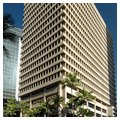Clean, crisp, rich, and warm, the twenty-two-story Davies Pacific Center presents Honolulu with another graceful high-rise tower. Balancing the vertical thrust of the upper stories' precast-and reinforced-concrete units, an engaging lower level welcomes pedestrians with arcades on the mauka and makai sides and a coconut-embowered, paved corner plaza with a volcano-like, conical fountain. An elevated terrace, accessed from the lobby or mauka-side steps, overlooks the plaza. The reddish-buff, lava-rock cinders used as aggregate in the poured-in-place concrete lower stories lend a warm hue to the whole. The diagonal of the plaza flows into the foyer of the building with its shop-lined passageway.
Tom Van Sant's five large, concrete intaglio sculptures, depicting scenes related to pineapple cultivation, whaling, ranching, maritime mercantile endeavors, and sugar plantations humanize and localize the building. These recall various enterprises associated with the activities of Theo H. Davies and Company, one of Hawaii's “Big Five” sugar factors. Tracing its roots back to the mercantile venture Starkey, Janion and Company, which opened its store in Honolulu in 1845, this British-based company emerged as the largest distributor of general merchandise in the Islands, and was also deeply involved in the sugar industry, operating several plantations along the Hamakua coast of the island of Hawaii. In addition to sugar interests, the Theo Davies company also owned Honolulu Iron Works, served as an agent for a multitude of insurance companies, and maintained a lumber and building supply department, having purchased Allen and Robinson, one of Honolulu's oldest lumber concerns, in 1930. The company remained in the Davies family's hands until 1973 when it was sold to Jardine Matheson of Hong Kong.





